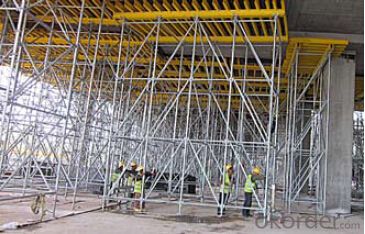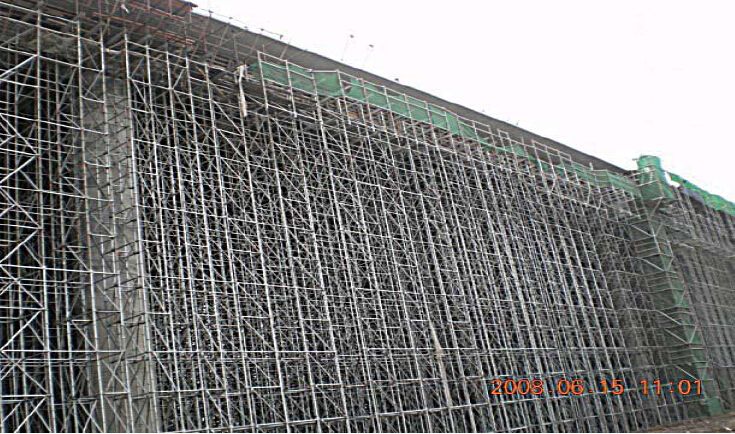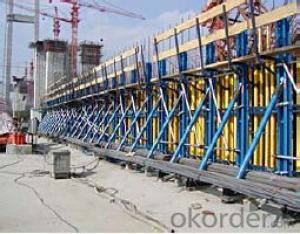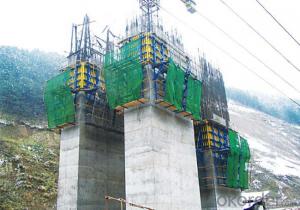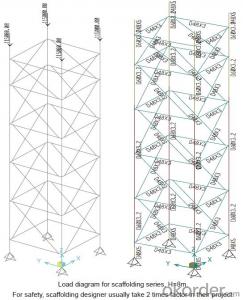Tower Scaffolding for Formwork and Scaffolding Build
- Loading Port:
- Tianjin
- Payment Terms:
- TT OR LC
- Min Order Qty:
- 50 m²
- Supply Capability:
- 1000 m²/month
OKorder Service Pledge
Quality Product, Order Online Tracking, Timely Delivery
OKorder Financial Service
Credit Rating, Credit Services, Credit Purchasing
You Might Also Like
Tower Scaffolding
Shoring tower is an effective supporting system. It is easy to assemble and dismantlement, and
has excellent stability and bearing capacity. It has been widely used in the construction of industry
& residential buildings , bridges, tunnels and dam project, etc.
Characteristics:
◆ High degree of standardization.
◆ Easy storage and transportation
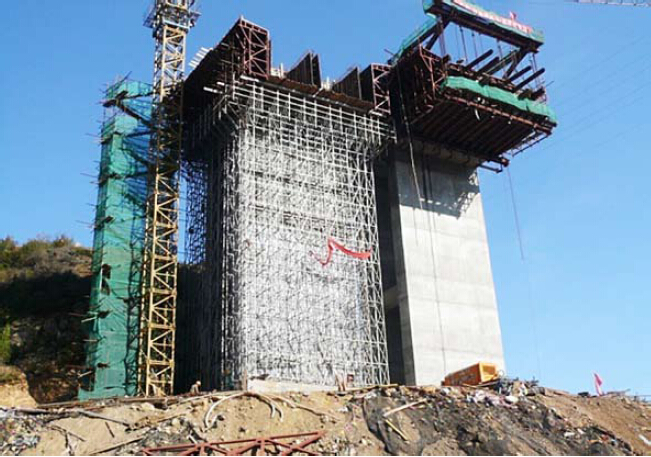
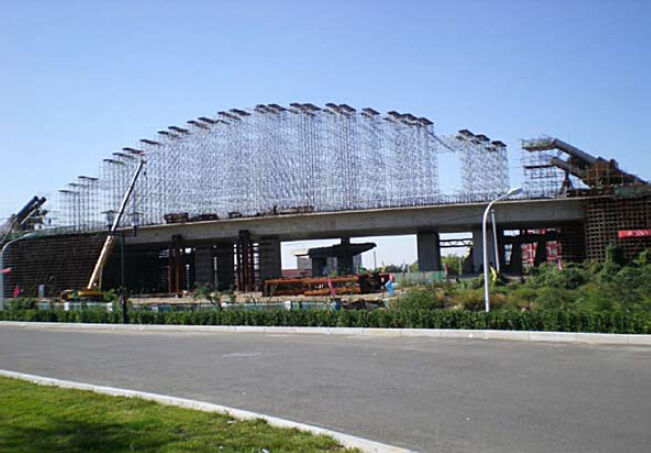
- Q: Can steel formwork be easily modified or adjusted during construction?
- Certainly, modifications or adjustments to steel formwork can be easily made during the construction process. Steel formwork is renowned for its ability to be flexible and adaptable, enabling convenient and swift modifications to meet project specifications. The design of steel formwork systems ensures modularity, enabling effortless assembly and disassembly, thereby facilitating simple modifications or adjustments to the formwork structure. Furthermore, steel formwork can be effortlessly cut, welded, or bolted together to produce custom formwork shapes or sizes. This adaptability of steel formwork makes it the preferred choice for construction projects that frequently require modifications or adjustments.
- Q: How does steel formwork handle formwork removal and storage?
- Steel formwork is known for its durability and strength, which makes it highly suitable for handling formwork removal and storage. When it comes to formwork removal, steel formwork can be easily disassembled and removed from the concrete structure. This is primarily due to the modular nature of steel formwork, which allows for easy dismantling and reassembly. Steel formwork systems often consist of standard-sized panels that can be quickly and efficiently removed by loosening the connecting bolts or clips. This process ensures that the formwork can be easily dismantled without causing damage to the concrete structure or the formwork itself. Additionally, the lightweight nature of steel formwork allows for easy handling during removal, reducing the risk of accidents or injuries. In terms of storage, steel formwork offers several advantages. Firstly, steel formwork can be stacked and stored in a compact manner, saving space in construction sites or storage facilities. The modular design of steel formwork panels allows for easy stacking and organization, ensuring that the formwork can be efficiently stored without taking up excessive space. Furthermore, steel formwork is less susceptible to damage from weather conditions compared to other types of formwork materials such as wood or plywood. Steel formwork can withstand exposure to rain, sunlight, and temperature fluctuations without warping, rotting, or deteriorating. This durability makes steel formwork a reliable option for long-term storage, as it can be reused multiple times without significant degradation. Overall, steel formwork provides a superior solution for formwork removal and storage. Its strength and durability allow for easy dismantling and removal, while its modular design and compact storage capabilities make it an ideal choice for efficient storage. With these advantages, steel formwork contributes to increased productivity and cost-effectiveness in construction projects.
- Q: Plastic building templates where there is an urgent need to solve
- Plastic building template is an energy-saving and environment-friendly products, after the wooden template, composite steel formwork, bamboo plywood, all steel template and a new type of product. Can completely replace the steel formwork, formwork, timber, traditional energy saving and environmental protection, low cost amortization
- Q: Can steel formwork be used for water tanks or swimming pools?
- Steel formwork is a versatile option for constructing water tanks or swimming pools. With its durability and strength, it can withstand the pressure exerted by water, ensuring a stable and leak-free structure. Furthermore, the flexibility of steel formwork allows for easy customization to achieve the desired shape and size. Additionally, its convenient assembly and disassembly make it a convenient choice for construction projects. Nonetheless, it is crucial to properly waterproof and coat the steel formwork to prevent corrosion and maintain the integrity of the water tank or swimming pool.
- Q: What are the different types of corner solutions available for steel formwork?
- There are several different types of corner solutions available for steel formwork, each with its own advantages and applications. 1. External Corner Solutions: These are typically L-shaped or angled brackets that are used to form external corners in concrete structures. They are easy to install and provide a clean and sharp finish to the corners. External corner solutions are commonly used in building construction, especially for walls and columns. 2. Internal Corner Solutions: Similar to external corner solutions, internal corner solutions are used to form internal corners in concrete structures. They can be either L-shaped or U-shaped brackets, depending on the specific requirements. Internal corner solutions are commonly used in the construction of walls, slabs, and beams. 3. Adjustable Corner Solutions: These are versatile corner solutions that allow for adjustable angles and dimensions. They are designed to accommodate various corner configurations, making them suitable for complex structures or irregular shapes. Adjustable corner solutions are often used in the construction of curved walls, circular columns, and other unique architectural features. 4. Hinged Corner Solutions: Hinged corner solutions are specialized brackets that allow for easy removal of formwork after the concrete has cured. They feature hinges that enable the formwork to be opened and closed, providing quick and efficient access to the concrete surface. Hinged corner solutions are commonly used in applications where frequent access to the concrete surface is required, such as in tunnels or underground structures. 5. Reinforced Corner Solutions: These corner solutions are specifically designed to provide additional strength and support to the corners of concrete structures. They are reinforced with steel bars or plates to enhance the structural integrity and durability of the formwork. Reinforced corner solutions are commonly used in high-rise buildings, bridges, and other heavy-duty structures. Overall, the choice of corner solution depends on the specific requirements of the construction project, including the desired finish, structural integrity, and ease of installation and removal. It is important to consider these factors and consult with a structural engineer or formwork specialist to determine the most suitable corner solution for a particular application.
- Q: What are the common cost-saving strategies when using steel formwork?
- There are several common cost-saving strategies when using steel formwork in construction projects. 1. Reusability: One of the key advantages of steel formwork is its ability to be reused multiple times. By properly maintaining and storing the formwork after each use, it can be used for several projects, reducing the need for new formwork and ultimately saving costs. 2. Durability: Steel formwork is known for its durability and long lifespan. It can withstand high pressures and can be used for a longer duration compared to traditional formwork materials like timber. This durability reduces the need for frequent repairs or replacements, leading to cost savings in the long run. 3. Efficiency: Steel formwork allows for faster and more efficient construction compared to traditional formwork methods. The ease of assembly and disassembly, along with the use of hydraulic systems, enables faster construction cycles and reduces labor costs. Additionally, the precision and accuracy of steel formwork ensure minimal material wastage, further contributing to cost savings. 4. Safety: Steel formwork offers enhanced safety features compared to other formwork materials. It provides stability and structural integrity, which reduces the risk of accidents during construction. A safer working environment means lower insurance costs and potential legal liabilities, resulting in cost savings. 5. Reduced labor costs: Steel formwork is typically lighter and easier to handle compared to other materials. This reduces the number of workers required for installation and removal. Additionally, the speed and efficiency of steel formwork result in reduced labor hours, leading to cost savings. 6. Lower maintenance costs: Steel formwork requires minimal maintenance compared to other formwork materials. Regular cleaning and proper storage are typically sufficient to maintain its performance. This eliminates the need for expensive maintenance or repairs, resulting in cost savings over time. 7. Improved quality: Steel formwork ensures consistent quality in construction. It provides accurate dimensions and smooth finishes, reducing the need for additional finishing work. This saves both time and money, as there is no need for additional materials or labor to rectify imperfections. Overall, the common cost-saving strategies when using steel formwork revolve around its reusability, durability, efficiency, safety, reduced labor costs, lower maintenance costs, and improved quality. By considering these strategies, construction projects can optimize their budget and achieve significant cost savings.
- Q: Can steel formwork be used for both large and small construction projects?
- Yes, steel formwork can be used for both large and small construction projects. Steel formwork offers several advantages such as durability, strength, and reusability, which make it suitable for a wide range of projects. For large construction projects, steel formwork provides the necessary structural support to handle heavy loads and withstand the pressures of large-scale construction. Additionally, its ability to be easily assembled and disassembled allows for efficient construction processes. On the other hand, for small construction projects, steel formwork offers cost-effectiveness and flexibility. Its reusability allows for multiple uses, minimizing the need for additional formwork materials and reducing construction costs. Overall, steel formwork is a versatile option that can be adapted to meet the requirements of both large and small construction projects.
- Q: Are there any specific considerations for using steel formwork in areas with limited space?
- Yes, there are several specific considerations for using steel formwork in areas with limited space. Firstly, the dimensions of the steel formwork system should be carefully chosen to ensure that it can fit into the available space. This includes considering the height, width, and depth of the formwork components, as well as any necessary clearances for movement and installation. Secondly, the assembly and disassembly of the steel formwork system should be carefully planned to minimize the space required. This may involve using smaller formwork panels or modular systems that can be easily transported and maneuvered in tight spaces. Additionally, the sequencing of formwork removal should be considered to ensure that there is enough space for workers and equipment to safely access the area. Thirdly, the storage of steel formwork components when not in use should be taken into account. In areas with limited space, it may be necessary to stack the formwork panels vertically or utilize compact storage solutions to maximize space efficiency. Lastly, the accessibility of the construction site should be considered. In areas with limited space, it may be challenging to transport and deliver the steel formwork components. It is important to evaluate the availability of access roads, parking areas, and equipment staging areas to ensure that the steel formwork can be safely and efficiently delivered to the construction site. Overall, using steel formwork in areas with limited space requires careful planning and consideration of the dimensions, assembly, disassembly, storage, and site accessibility. By addressing these specific considerations, it is possible to effectively utilize steel formwork systems in tight spaces while ensuring the safety and efficiency of the construction process.
- Q: How does steel formwork affect the overall thermal insulation of a building?
- Steel formwork does not directly impact the overall thermal insulation of a building. The purpose of steel formwork is to provide structural support during the construction process, allowing the concrete to be poured and shaped into the desired form. It is a temporary structure that is removed after the concrete has cured. Thermal insulation in a building is primarily determined by the materials used in the walls, roof, and floors, as well as the design and installation of insulation systems. These materials and systems are separate from the steel formwork used during construction. However, it is worth noting that the use of steel formwork may have an indirect effect on the thermal insulation of a building. The construction process itself, including the use of formwork, can impact the overall quality of the insulation installation. If not properly managed, the installation of insulation materials during or after the removal of steel formwork may be compromised, leading to gaps, voids, or poor installation that can affect thermal insulation. Therefore, it is essential to ensure that proper construction practices are followed, and insulation materials are correctly installed after the removal of steel formwork. This will help maintain the intended thermal insulation performance of the building.
- Q: How does steel formwork affect the overall construction site aesthetics?
- Steel formwork can greatly enhance the overall aesthetics of a construction site. Its sleek and modern appearance gives a professional look to the project, creating a sense of organization and efficiency. Steel formwork's clean lines and smooth finishes provide a visually pleasing backdrop for the construction process, improving the overall visual appeal of the site. Additionally, its durability and ability to create precise and intricate designs contribute to a more refined and sophisticated aesthetic outcome.
Send your message to us
Tower Scaffolding for Formwork and Scaffolding Build
- Loading Port:
- Tianjin
- Payment Terms:
- TT OR LC
- Min Order Qty:
- 50 m²
- Supply Capability:
- 1000 m²/month
OKorder Service Pledge
Quality Product, Order Online Tracking, Timely Delivery
OKorder Financial Service
Credit Rating, Credit Services, Credit Purchasing
Similar products
Hot products
Hot Searches
Related keywords


